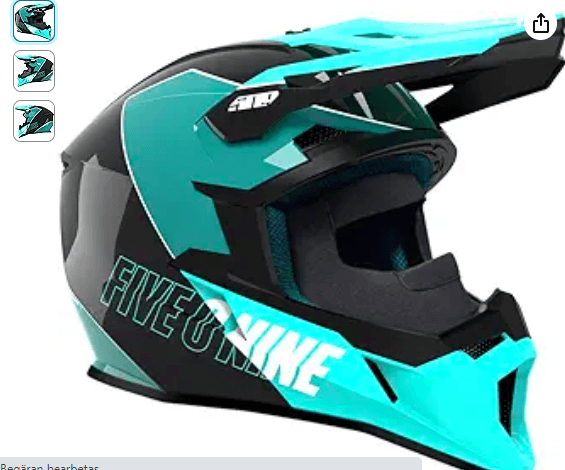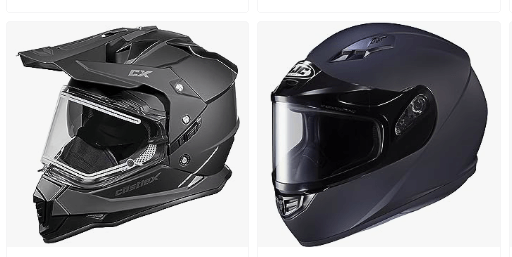
How To Choose The Best Snowmobile Helmet
When it comes to snowmobiling, your safety and comfort are critical. Choosing the correct helmet is an important part of ensuring a safe and fun snowmobile experience. Snowmobile helmets not only protect your head from potential collisions, but they also protect you from the biting cold and flying debris that might be encountered on snow-covered tracks.
Choosing the finest snowmobile helmet is a critical choice that involves careful consideration of several criteria, ranging from safety regulations to fit, type, and extra features. In this detailed guide, we will lead you through the main factors of picking the ideal snowmobile helmet, ensuring that your head and face are protected as you ride your snowmobile through the winter wonderland.
Whether you’re a seasoned rider or just starting out, making an informed selection about your helmet is an investment in your safety as well as the overall enjoyment of your snowmobile experiences.
How much is snowmobile helmet?

The price of a snowmobile helmet may vary greatly based on a variety of aspects such as brand, features, materials, and quality. To give you a sense of the pricing range, below is an example:
Helmets for Beginners:
These helmets normally cost between $100 and $200. They provide minimal protection and may lack some of the advanced features available in more expensive helmets.
Helmets in the Mid-Range:
Mid-priced helmets often vary between $200 and $400. They provide enough protection, comfort, and some additional comforts while maintaining an excellent price-to-feature ratio.
Premium Helmets:
High-end snowmobile helmets can cost between $400 and $800 or more. These helmets frequently have modern safety technologies, high-quality materials, enhanced insulation, improved ventilation, and extra functions like as integrated communication systems or Bluetooth connection.
Modular Helmets:
Because of their versatility and increased convenience, modular helmets, which let you to swap between full-face and open-face configurations, are frequently in the mid to high price range.
Helmets for Children:
Helmets for children and juvenile riders can cost anywhere from $70 to $200, depending on quality and features.
Remember that pricing isn’t the only determinant of a helmet’s quality or fit for your needs. It is critical to select a helmet that fits well, satisfies safety regulations, and provides adequate protection for your snowmobile style and local weather conditions. When choosing a snowmobile helmet, safety should always be the first concern, so invest in a helmet that delivers the ideal blend of safety, comfort, and features within your budget.
What To Know Before Choosing A Snowmobile Helmet.

It is critical to select the best snowmobile helmet for your safety and comfort when riding. Consider the following elements in our comprehensive guide to make an educated decision:
1-Safety Standards:
Check to see if the helmet meets recognised safety requirements. Look for helmets that meet DOT (Department of Transportation) or Snell requirements in North America. These certifications confirm that the helmet meets specified safety standards.
2- Helmet Type:
There are various varieties of snowmobile helmets available, each with varying degrees of protection and features:
Full-Face Helmet:
Provides optimum protection by covering your whole head and face. Ideal for biking at high speeds in chilly weather.
Helmet with a modular design:
For increased convenience, the front part flips up. You may quickly switch between full-face and open-face modes.
Open-Face Helmet:
Provides less protection but may be more comfortable in warmer weather. These helmets are popular among casual motorcyclists.
3- Fit:
A correct fit is critical for both safety and comfort. To determine the proper size:
With a flexible tape measure, measure the diameter of your head slightly above your brows and ears.
Try on helmets to find the one that fits snugly but comfortably. The helmet should be level on your head, with no forward or backward tilt.
4- Air circulation:
Adequate ventilation is necessary to avoid fogging and overheating. Look for helmets that have adjustable vents so you can manage the airflow.
5- Visor/Shield:
Consider the visor or shield that is included with the helmet:
Dual-Pane Visors: These prevent fogging by trapping an air layer between two panes. Ideal for chilly weather.
On bright days, tinted visors provide sun protection.
Quick-Release Visor: Allows for quick visor removal and replacement.
6- Insulation:
Choose a helmet with enough insulation to keep you comfortable when riding in cold weather. Removable liners are advantageous since they enable you to adjust to changing conditions.
7- Weight:
Lighter helmets are more comfortable for lengthy rides, but be sure that the weight reduction does not compromise safety.
8- Security Features:
Some helmets include extra safety features such as:
Systems of Integrated Communication:
Helmet communication devices allow you to communicate with other riders in your group.
Bluetooth compatibility:
Connects your helmet to your phone or other devices to allow for hands-free conversation and music.
Quick-Release Buckles:
Make it simple to put on and take off your helmet, even when wearing gloves.
9- Price:
Make a budget, but keep in mind that your safety should be your main concern. High-quality helmets are more expensive, but they are well worth the price.
10- Style and Visibility:
Consider using a bright and noticeable helmet to increase your visibility on the snowmobile routes. Reflective components can also help with visibility, particularly in low-light situations.
11- Brand Reputation and Customer Feedback:
Examine the brand’s reputation and read reviews from other snowmobilers to gain insight into real-world performance and durability.
12. Accessories:
To improve comfort and performance, look for extras such as breath guards, helmet bags, and balaclavas.
Finally, the best snowmobile helmet is one that fits comfortably, provides adequate protection for your riding style and conditions, and has features that make your snowmobiling experience safe and fun. When making a decision, try on helmets in person, evaluate possibilities, and prioritise your unique needs and preferences.
FAQs About How to choose the right snowmobile helmet
Why is a snowmobile helmet required?
Snowmobile helmets are required for your protection when riding. They shield your head and face from crashes, cold weather, and flying debris, lowering your chances of suffering a head injury.
What safety features should a snowmobile helmet have?
Look for helmets that fulfil DOT or Snell standards, as these certifications provide a specific amount of protection. Different regions may have their own set of safety requirements.
What exactly is the distinction between a full-face, modular, and open-face snowmobile helmet?
For best safety, use a full-face helmet that covers your complete head and face. Modular helmets include a flip-up front portion that allows you to choose between full-face and open-face protection. Open-face helmets offer less protection but may be more comfortable in warmer weather.
How should a snowmobile helmet fit?
A good fit is tight but not uncomfortable. Measure the circumference of your head and select the appropriate size. The helmet should be level on your head, with no forward or backward tilt.
How can I prevent visor fogging in my snowmobile helmet?
Consider helmets with dual-pane visors that trap a layer of air to avoid fogging. You may also apply anti-fog treatments or gently fracture the visor to enable ventilation. Some helmets have ventilation systems that are intended to decrease fogging.
Can I use a motorcycle helmet for snowmobiling?
It is not advised to use a motorcycle helmet when snowmobiling. Snowmobile helmets are built to resist lower temperatures and provide superior protection from wind, snow, and cold.
What are the safety features to look for in a snowmobile helmet?
For enhanced convenience and safety, some helmets include integrated communication systems, Bluetooth connection, and quick-release buckles.
Are there different kinds of snowmobile helmets, such as trail riding or backcountry riding?
Some helmets are specifically built for particular sorts of riding. Consider helmets with greater ventilation for vigorous use for backcountry riding, whereas trail riding helmets may prioritise insulation and comfort.
Is a separate helmet required for juvenile or youngsters snowmobilers?
Yes, it is critical to get a helmet that is especially tailored for the child’s size and age. Snowmobile helmets for children are offered to provide optimum fit and safety.
The above is a summary of How to choose the right snowmobile helmet.






